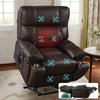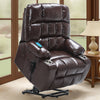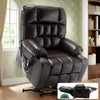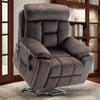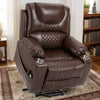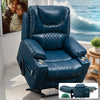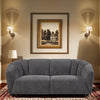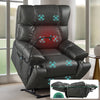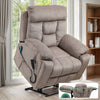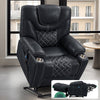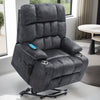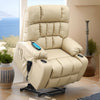Understanding the Importance of Power Lift Chairs in Home Care
The Role of Power Lift Chairs in Mobility Aid
Power lift chairs play a crucial role in enhancing mobility for older adults. These chairs offer easy transitions from sitting to standing positions. This feature is vital for those with limited mobility or strength. Lift chairs reduce the risk of falls and injuries during these movements. They provide independence and confidence to users in their daily activities. The chairs also offer comfort and support, easing pain from conditions like arthritis. By promoting movement, they help maintain muscle strength and circulation. Power lift chairs are more than just furniture; they're a key tool in home care.

Assessing the Impact of Lift Chairs on Quality of Life
Lift chairs significantly improve the quality of life for older adults. They offer greater autonomy, reducing reliance on caregivers for basic movements. This independence boosts self-esteem and mental well-being. Users report less pain and discomfort in daily activities. The chairs allow for better participation in social interactions and hobbies. They reduce the fear of falling, a common concern among older adults. This increased sense of safety leads to more active lifestyles. Lift chairs also benefit caregivers by reducing physical strain and injury risk. Overall, these chairs contribute to a more positive and engaged life for seniors.
The Evolution of Power Lift Chair Design
Power lift chair design has come a long way over the years. Early models were basic and focused solely on the lifting mechanism. Modern chairs now offer a range of features for comfort and functionality. Many include heat and massage options for added therapeutic benefits. Advanced models have multiple position settings for various activities. Some chairs now integrate smart technology for easier control and customization. Designers focus on aesthetics, creating chairs that blend with home decor. Materials have improved, offering better durability and easier maintenance. The evolution continues, with ongoing research into user needs and preferences.
How Power Lift Chairs are Revolutionizing Elder Care in the United States
The Growing Need for Mobility Assistance in Aging Populations
The U.S. is facing a rapid increase in its aging population. This growth brings a higher demand for mobility assistance tools. Many older adults prefer to age in place, staying in their own homes. Power lift chairs are becoming essential in supporting this preference. They address common mobility issues that come with aging. These chairs help manage conditions like arthritis, back pain, and muscle weakness. They reduce the need for full-time care, promoting independence. As awareness grows, more families are considering lift chairs as a care solution. This trend is changing how we approach elder care in home settings.

Power Lift Chairs: Bridging the Gap in Home Care Services
Power lift chairs are filling a crucial gap in home care services. They offer a middle ground between full independence and assisted living. These chairs provide support that might otherwise require a caregiver's presence. They allow older adults to perform daily tasks with minimal assistance. This reduces the burden on both family caregivers and healthcare systems. Lift chairs complement other home care services, enhancing overall care quality. They can delay the need for more intensive care arrangements. By promoting independence, they support the emotional well-being of older adults. Lift chairs are becoming an integral part of comprehensive home care strategies.
The Economics of Investing in Lift Chairs for Elderly Care
Investing in power lift chairs can be economically beneficial in elderly care. These chairs can reduce healthcare costs associated with falls and injuries. They may delay the need for more expensive care options like nursing homes. While the initial cost may seem high, the long-term savings can be significant. Many insurance plans now recognize the value of lift chairs and offer coverage. The chairs can reduce caregiver expenses by promoting independence. They may also lower medical costs related to sedentary lifestyles. For families, the investment often pays off in reduced care hours and stress. As demand grows, more affordable options are entering the market.
Selecting the Right Power Lift Chair for Your Needs
Key Features to Look for in a Power Lift Chair
When choosing a power lift chair, several key features should be considered. Look for smooth and quiet lifting mechanisms for comfort and ease of use. Check the weight capacity to ensure it suits the user's needs. Consider the number of positions available, from basic recline to full lay-flat. Look for durable, easy-to-clean fabrics that resist wear and stains. Assess the chair's size to ensure it fits both the user and the room space. Some chairs offer heat and massage features for added comfort. Check for battery backup options in case of power outages. Look for easy-to-use controls, including remote options. Consider chairs with USB ports for charging devices. Evaluate the warranty and customer support offered by the manufacturer.

The Process of Evaluating Lift Chairs for Different Users
Evaluating lift chairs for different users requires a personalized approach. Start by assessing the user's specific mobility needs and health conditions. Consider their height and weight to ensure proper fit and support. Evaluate their home environment and available space for the chair. Take into account any specific pain points or comfort preferences. Consider the user's ability to operate controls and adjust settings. Assess how easily they can get in and out of different chair models. Think about potential future needs as the user's condition may change. Consult with healthcare providers for recommendations based on medical needs. If possible, have the user test different models before making a decision. Consider feedback from other users with similar needs and conditions.
Ensuring Compatibility with Home Infrastructure and Design
When selecting a power lift chair, compatibility with home infrastructure is crucial. Measure doorways and passages to ensure the chair can be moved into place. Check for nearby electrical outlets to power the chair without extension cords. Consider the room's layout and how the chair will fit with existing furniture. Evaluate flooring types to ensure the chair won't damage or be unstable on the surface. Think about the chair's style and color to match or complement the room's decor. Consider any home modifications that might be needed, like widening doorways. Check if the chair requires additional space for full recline or lift functions. Ensure there's enough room for safe movement around the chair when in use. Consider lighting placement to avoid glare on controls or viewing areas. Assess if any smart home features can integrate with the chair for added convenience.








